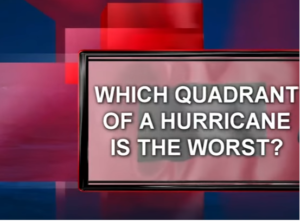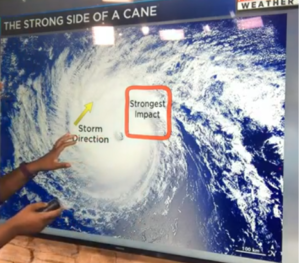From Katrina to Sandy, to the ongoing hurricane Dorian, tropical storms are creators of mass destruction. Their winds are powerful, sweeping aside anything it can get its windy hands on. At wind speeds reaching a minimum of 74 miles per hour, even the “weakest” hurricane is faster than a cheetah, the fastest animal on land.

The Most Dangerous Parts of a Hurricane
Regardless of where you are, the way anyone sees it is the fact that any hurricane is dangerous and is a force of nature to reckon with. Besides the typical categorization system we have in place, what most people don’t know is that the different quadrants of a hurricane also tell their own individual stories of the damage that they cause.
While the headlines of Dorian are still fresh in people’s minds, let’s imagine being way up above the storm and looking down on it from a bird’s eye view. From there, envision the swirling mass of terror beneath you cut into four sections, like a typical coordinate graph, with the eye as the origin.
Hurricane Quadrant 1: the top right
This is the most dangerous and powerful quadrant of the hurricane. Like in a film studio, this is where the action takes place. The fastest winds, the heaviest torrential rains, the surges of the tropical storm lie in the first hurricane quadrant.
In the occasion that the hurricane is severe enough to form a tornado, this is where the tornado is birthed and released. The tornadoes are usually short-lived and do not travel extensively far away from the first quadrant.
Quadrant 2: the top left
For coastal areas, this will be the place of undesirable effects. The second quadrant is the most dangerous area for storm surges. A hurricane is a double threat with both wind and intensive storm surges wreaking havoc on the area. A storm surge is the water from the ocean that gets pushed to the shore by the extreme winds swirling around inside the hurricane.
These are called storm surges for a very good reason: combined with the natural breakers out in the oceans, these waves join together to make a tidal wave of destruction. They erode beaches, flood coastal highways, and people’s homes. Storm surges in this quadrant of the hurricane are the most severe and will strike against and take out boats and even buildings.
Quadrant 3: the bottom left
Of course any playground bully has its weakest point, and this takes place in the form of the third quadrant of a hurricane. While this is technically the least threatening location of a hurricane, this by no means says that you should not take precautions.
If the category of the hurricane is in the higher level of severity like a 3 or above, even in the “weakest” point will you find great damage.
Quadrant 4: the bottom right
While quadrant 2 takes the cake for the severest storm surges, this hurricane quadrant is the wind warrior. Apart from the eye wall, the victims of this hurricane quadrant will experience the most intense winds of the storm. What is the strongest part of a hurricane called?
In the occasion of a category 5 hurricane, winds are already blowing at 157 or more miles per hour. Avoid being in rooms or buildings close to any windows or glass. Wind should always be taken seriously as it can lead to an endless cycle of throwing things all around like a projectile.

What are the Parts of a Hurricane?
The Eye
Some people will reference being in the eye of the storm. Essentially the eye is the hole at the center of a hurricane or tropical storm. This is the most peaceful part of the storm where the winds are light and partly cloudy skies are there.
The Eye Wall
As mentioned earlier, the eye wall is the place for the strongest and fastest winds. The eye wall is composed of a ring of thunderstorms that swirl in a thick barrier around the eye.
Rain Bands
These bands are spiral stretches of clouds, rain, and thunderstorms. The rain bands will extend from the hurricane’s eye wall and stretch for hundreds of miles out where the tornadoes also start to form.
Sources:
https://www.nasa.gov/audience/forstudents/5-8/features/nasa-knows/what-are-hurricanes-58.html





